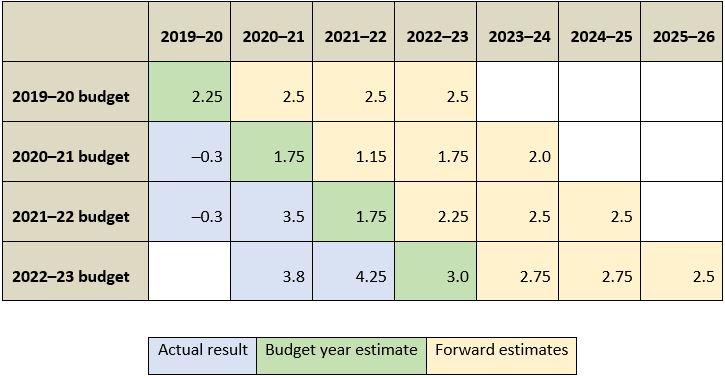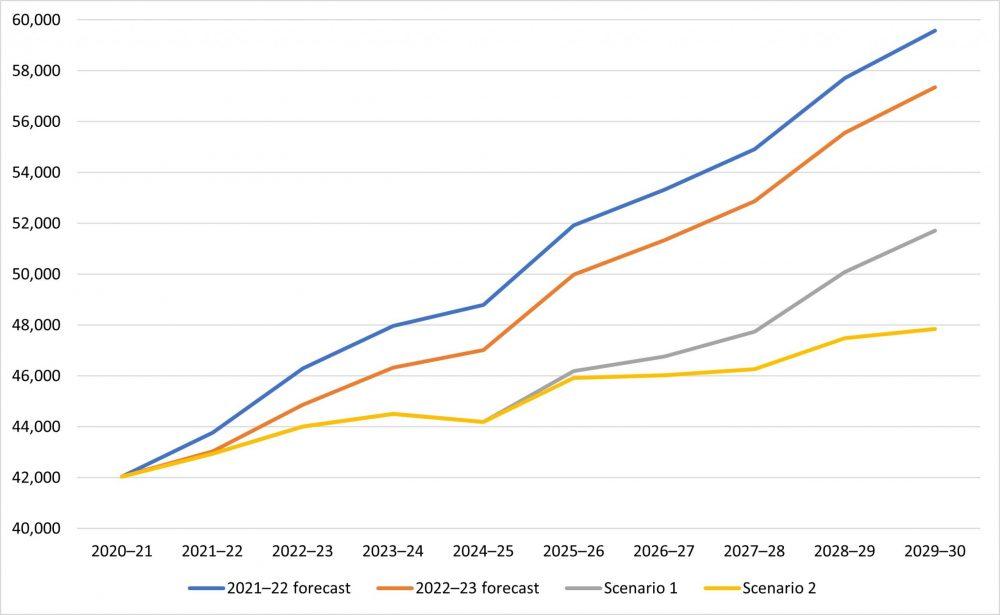
A key challenge for the defence budget is inflation, which eats into not just the average Aussie family’s buying power, but also the government’s. The higher the rate of inflation, the more the defence budget will be eroded in real terms. Analysts in the US, where inflation is running at around 8%, have expressed concern about its impact on the nation’s defence budget. But Australia’s Department of Defence won’t be immune from inflation’s debilitating effects either.
Over the past two decades, Australia has had relatively low rates of inflation, with 2.25–2.50% being the norm (using the consumer price index). We can assume that the 10-year funding lines included in the 2016 defence white paper and 2020 defence strategic update were developed using that rate of inflation.
But the Covid-19 pandemic has changed that stable picture. First, we had a year of deflation in 2019–20, but since then inflation has increased beyond the norms of recent history. It hit 3.5% in 2020–21.
The government predicted 1.75% for 2021–22 but had to revise that up to 4.25% in the 2022–23 budget. That may need further revision; on 27 April the Australian Bureau of Statistics reported that inflation had risen by 5.1% over the 12 months to March. The governor of the Reserve Bank of Australia said this week that it could hit 6% before it moderates.
Australian government inflation, actual and predicted, 2019–20 to 2025–26 (%)

Source: Budget paper no. 1.
In fairness to the government, accuracy hasn’t been a feature of anybody’s economic predictions in the age of Covid. At the moment, a lot of money (in part generated by various Covid relief measures) has been seeking a reduced amount of goods and services (caused by supply-chain disruptions, lack of workers, sanctions in the energy sector and so on), driving inflation. The government is assuming those disruptions will end and inflation will decrease to 3.0% in 2022–23 and eventually back to a more ‘normal’ 2.5% by the end of the forward estimates. I’m not going to argue for any particular number, but when we’re thinking about risks, it can be helpful to consider scenarios.
Let’s start with the government’s own numbers. Already, the rise in inflation in 2021–22 from the government’s prediction of 1.75% at the start of the financial year to its current estimate of 4.25% has had the effect of eroding more than $700 million from the defence budget in real terms. Using the inflation predictions in the 2022–23 budget papers results in a further loss of $1.4 billion in 2022–23. By the end of the forward estimates in 2025–26, the defence budget will be 3.7% lower in real terms. That might not sound like much, but it represents a cumulative loss of buying power of around $6.8 billion over the forward estimates and $15.2 billion over the decade.
To give a sense of scale, this year the planned spending on naval shipbuilding is $1.6 billion. Nearly that much has already evaporated this year alone even before the shortfalls compound over time.
That’s if we use the government’s official inflation predictions. But we can generate more worrying scenarios. One in which inflation hits 5% but returns to ‘normal’ more slowly, not getting there until late this decade, produces a cumulative reduction in real terms of $16 billion over the forward estimates and $45 billion over the decade (scenario 1 in the figure below). A second scenario in which inflation of 5% becomes the new normal results in a 20% annual reduction in real terms by the end of the decade and a cumulative reduction of $54 billion. A reduction in real buying power of that scale will have a huge impact on Defence.
Effects of inflation on the defence budget (2021–22 real $ million)

Source: ASPI modelling.
We should also bear in mind that around two-thirds of Defence’s equipment acquisition budget goes overseas, largely to the US. So even if inflation moderates here, Defence’s buying power can still be eroded by cost increases overseas.
In sum, if inflation remains above historical levels, it will quickly eat into Defence’s buying power even if whichever government is formed after the election adheres to the funding outlined in the 2020 defence strategic update. To manage that, the government will need to accept reductions in capability or increase the defence budget just to acquire and support Defence’s currently planned capability. That’s before it even considers any increases to meet our worsening strategic circumstances.